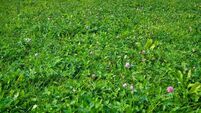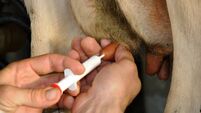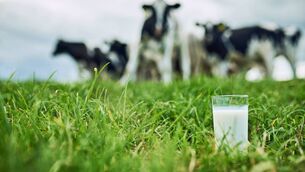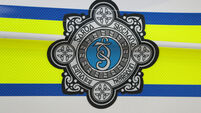Double Trouble - dealing with twin calvings
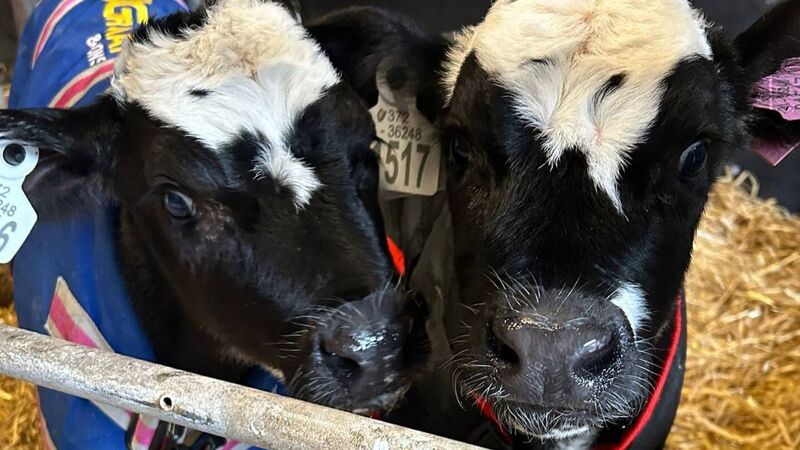
One of Hazell's sets of twin calves born on her family farm in Carrignavar, Co Cork.
Spring has sprung on the farm, and it's double the excitement this year with the arrival of two sets of twins within two days of each other. The first set (a bull and a heifer) was from a cow that has a long history of twins, so it is not her first rodeo, with this being the third year of twins. The second cow was a younger cow and had gorgeous twin bull calves with the most unusual markings.
Twins can be due to a negative energy balance during the time of breeding which can induce double ovulations.
I think we can all recall the horror of last year with the long housing period and the poor grass growth that followed in the summer, perhaps it could lead to more sets of twins this spring, we will have to wait and see.
Typical that the morning the first set of twins arrived, the cow went down with milk fever just before she calved. This was potentially caused by the fact that twins are a risk factor for milk fever in cows, and also being an older lady didn’t help matters.
The increased demand for calcium reserves near calving is due to colostrum production, which can be a higher volume for twin calves. Older cows have less calcium reserves in their skeletal system which can predispose them to milk fever.
Luckily, we realised this early on in the disease process, and I was able to treat her quickly to get her back on her feet to have her calves a few hours later.
I gave her a calcium bolus, which I repeated 24 hours later for continued calcium release for 48 hours. Oral calcium is shown to be easily absorbed and better than that calcium that is put under the skin. I had to give her IV calcium, too, as I find once the cow is down, it is required to give them that initial boost to get them back on their feet.
Aftercare for cows with twins is very important not only for milk fever prevention but also for preventing a multitude of metabolic diseases. Twins demand a lot from the cow; they have put themselves under pressure to grow them both for the past nine months, and now they are back in the parlour with cows that had a somewhat easier time during pregnancy.
Lots of TLC is required to give these dedicated twin mothers a good start to their lactation. For both clinical and subclinical milk fever prevention it is important to administer calcium boluses to cows expecting twins at the point of calving or else just after.
Feed intake after calving is so important for cows with twins to prevent metabolic disease associated with ketosis. Ketosis occurs when cows “milk off their back”, meaning they metabolise fat to sustain energy for milk production.
These fat-breakdown products can overwhelm the liver, and by-products called ketones are produced, they have a direct effect on the immune system, and they also cause a reduced feed intake.
It can be a vicious cycle where not eating post-calving can cause a rise in ketones, and the ketones themselves can cause even more of a reduction in feed intake due to suppressing the cow's appetite. There was a bolus that prevented ketosis in at-risk cows; however, it is no longer available. I was asked what is the best alternative to this now for cows post twins.
The answer is multifactorial, firstly it is to keep feed intake up, supplying lots of fresh feed at the food face, feeding a good transition diet and not forgetting giving her lots of space for her to eat is vital. A fresh cow drink that supplies the cows with calcium, vitamins, dextrose and fluids if super to get not only prevent milk fever but also to replace lost fluids at calving and encourage feed intake.
Administering 200ml of propylene glycol on the day of calving, followed by 100ml once a day for the next two days can help supply quick-release energy to prevent ketosis in the initial post-calving period.
Ketosis can cause issues such as a left displaced abomasum about ten days post-calving; it is, unfortunately, a common occurrence in cows with twins. It means that the abomasum, which is usually located on the right side, has moved to the left and is causing discomfort and digestive issues in the cow.
A noticeable drop in milk supply and having no interest in eating ration are the most common clinical signs. A vet visit can diagnose the issue and a surgery to correct is usually the port of call. Implementing a good twin protocol can prevent these issues from arising and make the transition to the milk herd more seamless.
The unfortunate outcome of the first set of twins is that the heifer has over a 95% chance of being a freemartin which means she will be infertile. This is due to the bovine placenta allowing the male hormones from the bull embryo to influence the development of the female embryo's reproductive organs very early in pregnancy.
Next week, I am back in Mitchelstown during the midterm break, I am looking forward to doing some calls and seeing some interesting cases. Love is in the air too this week with Valentine’s Day, but, more importantly, my Dad’s birthday; let’s hope the cows allow us some time to celebrate.
- Hazell Mullins BVM BVS, is a large animal vet based in Carrignavar, Co Cork.




